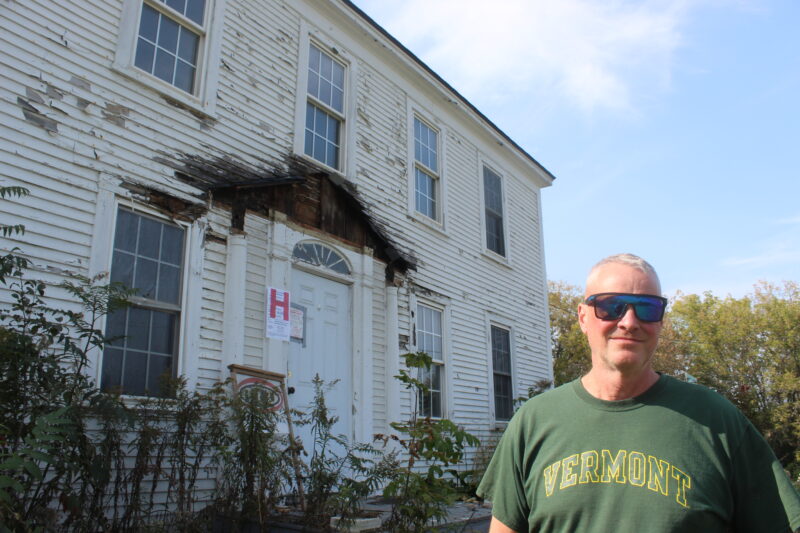Old building might usher in the future of East Charlotte
If you want to meet someone who is bullish about the future of East Charlotte, look no further than Jon Maguire. At a recent site visit with Maguire, his entrepreneurial vigor was clearly present. He is energetic and, perhaps most importantly, invested in the future of the east village. I first wrote about Maguire and his project in The Charlotte News in January 2023.
He is the proud owner of 15.4 acres on the corner of Spear Street and Hinesburg Road, known to locals as Baptist Corners, which includes the historic 1810 Sheehan house. His project includes adaptive reuse of the house as a restaurant, a new structure for commercial space with a residential unit above, plans for 20 units of senior housing in the southwest corner of the property and one new house.
Maguire says the Sheehan house will be a “true historical preservation,” adding that he is working with Vermont Historical Preservation. This is not Maguire’s first time at this rodeo. He completed the historic preservation of a similar house in Winooski a number of years ago.

Jon Maguire stands in front of the building usually referred to as the Sheehan house, which he is renovating into a restaurant in East Charlotte.
When I visited in January, Maguire’s project was in its infancy and he had yet to have a sketch plan review with the development review board. During my recent visit, a few weeks ago, progress abounded; the back section of the historic structure was demolished and replaced by an excavated area, ready for a new foundation.
Preparations are also underway to elevate the existing house by 2 feet. This will provide space for the restaurant’s kitchen.
The development review board unanimously approved the preliminary decision of Maguire’s major three-lot subdivision on July 26. Charlotte’s land-use regulations stipulate all development in the village districts must be major subdivisions, therefore, Maguire must submit a final plan in response to the development review board’s preliminary decision.
Maguire’s goal is for the restaurant to open in 2024 and begin work on the commercial and residential space, senior housing and house, sometime in 2025.
Maguire was quick to point out that working with the development review board and the conservation commission has been a positive experience. I asked about the neighbors’ opinions about the project, and he said it’s been positive.
The ideas behind this project have some history. Clark Hinsdale III contemplated developing senior housing and adaptive reuse of the Sheehan house at this site in the past. For those not familiar with Hinsdale, he was, until a few years ago, a long-time Charlotte resident, responsible for many developments in town, as well as the conservation of a significant amount of land in Charlotte.
I asked Hinsdale about Maguire’s project and he said he was “very pleased.” The property was not for sale and Maguire approached him. His initial interest was the tavern but he liked the broader vision and pursued it.
Hinsdale said he has been supporting Maguire’s efforts “wherever possible.”
In the past, Hinsdale had considered other projects in the east village on land which abuts Hinseburg Road, but has since sold it.
“Ideas have a life cycle as do people. I figured the time for me to do any of my plans for East Charlotte had come and gone,” Hinsdale said.
While walking the site, Maguire and I talked about the challenges of building moderately priced housing in Charlotte, specifically in the village districts. He believes there are developers interested in smaller homes on smaller lots. He thinks pre-fabricated or modular homes are a way to keep costs down.
Maguire also thinks there is development potential of the Hancock house and property which recently went on the market. It includes 13.46 acres of land, all within the village district and is located on Spear Street, just south of the intersection of Jackson Hill Road.
Charlie Pughe, chair of the planning commission, sees the potential of modest income housing differently. He recognizes the need for “workforce housing” or “starter homes,” but believes it is very difficult to achieve in Charlotte due to land costs, lack of municipal infrastructure and developers who are focused on profit.
He thinks developers are reluctant to build a moderately priced house when they can build one for a market value of 800K or more, regardless of the lot size. Kwiniaska Ridge is a good example of this. It also begs the question as to what is economically viable in the village and what exactly is a moderately priced home today and is it realistically “workforce housing.”
It comes down to the political will of the town. Pughe said, “Are our villages sustainable?”
I asked Hinsdale what changes he thought are necessary to the land-use regulations to encourage commercial and residential growth in the village districts. He said: “The community has rejected our health center, a gas station where there was a gas station, so perhaps we ought to be honest about our future and have our Town Plan and land-use regulations reflect the reality of what we do and don’t want.”
I said it sounded like he thinks there isn’t the will to change and encourage modest development in the village districts, and Hinsdale agreed.
Perhaps Maguire’s project at Baptist Corners will indicate otherwise; the start of the revitalization of the East Village.
(Peter Joslin is a former chair of the planning commission and a member of The Charlotte News board of directors. The opinions expressed here are his own and not necessarily those of the board.)

